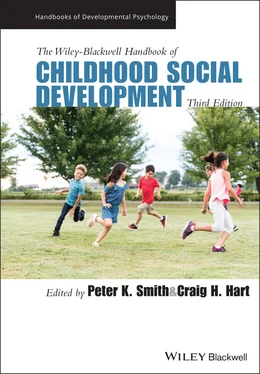Moral behavior was investigated primarily by examining children’s developing capacity to refrain from rule‐breaking and their ability to conform to moral standards (e.g., parents’ rules, values). Key objectives were to determine how and when children internalized moral rules (i.e., growth of conscience; Kochanska et al., 2010) and developed the ability to follow internalized rules, even in the absence of parental control. Other focal constructs included self‐control, self‐regulation, and delay of gratification. Evidence gathered on delay of gratification tasks, for example, indicated that children’s self‐control increased dramatically from the toddler through the preschool years (Cole et al., 2011), and correlated positively with brain maturation and maternal support (Bernier et al., 2010).
Investigators who studied moral emotions primarily focused on the development and determinants of guilt and shame. Such emotions were found to emerge in 2‐ and 3‐year‐olds, and correlated positively with both child factors (e.g., inhibited, fearful temperaments; female gender) and parenting practices (e.g., provision of support vs. anger following transgressions; Kochanska et al., 2002). Other findings suggested that children who manifested stronger expressions of guilt and remorse at early ages exhibited greater rule adherence and fewer moral transgressions at later ages (Tangney & Dearing, 2002).
Advances in this domain stemmed partly from the creation of coding schemes that reliably differentiated infants’ and children’s emotional expressions, and from the implementation of technologies that indexed emotion’s physiological referents (e.g., heart, brain, and CNS monitoring instruments). These innovations paved the way for researchers to distinguish among basic emotions (e.g., joy, fear, sadness) and self‐conscious emotions (e.g., pride, guilt), and to chart developmental milestones (e.g., emergence, stability) and gauge individual differences in emotional reactivity (Lewis, 2014).
Efforts to define and measure individual differences in emotions (e.g., forms expressed, intensity, regulation) and relate them to other aspects of children’s development produced important discoveries. Associations were found between the emotions children frequently expressed and their temperament and adjustment. Children prone to express positive affect, for example, were found to have outgoing temperaments and manifested better adjustment outcomes (e.g., higher self‐esteem, social competence). In contrast, negative affectivity was linked with inhibited and difficult temperaments and a range of adjustment problems (Rothbart, 2007). Similar differences in temperament and adjustment were found for children who evidenced greater as opposed to lesser ability to manage their emotions (e.g., self‐regulation, effortful control; Denham et al., 2011).
Aim 4: Identify the forms of socialization and the bio/psycho/social developments in children that predict adverse outcomes
Principal research aims included examining the effects of nonoptimal or aberrant socialization practices and rearing conditions, and ascertaining the sequela of risky child characteristics and maladies. Scientists who addressed these aims often did so in the context of short‐ and long‐term longitudinal investigations.
Disruptions, deviations, and dysfunctions in the family system
The principal aspects of the family system that were investigated as detriments to children’s development were child abuse, marital discord and divorce, parental depression, and insecure parent–child attachment. Evidence of child maltreatment within families (e.g., abuse, neglect, child death; Sedlak et al., 2010) spurred research on the consequences of child abuse. Findings supported the conclusion that maltreatment impairs children’s health and well‐being during childhood and thereafter (Cicchetti & Toth, 2006). For example, it was discovered that sexually abused children often developed inappropriate sexual behavior, internalizing disorders, and interpersonal difficulties (Sawyerr & Bagley, 2017; Trickett & Putnam, 1998), and that physically abused children manifested analogous as well as more serious dysfunctions (e.g., PTSD, suicidal thoughts, self‐injurious behaviors; Cicchetti & Toth, 2006).
Rising divorce rates spurred research on the effects of marital discord and divorce on children’s development. Studies of family conflict revealed that interparental hostility – particularly when severe, unresolved, and witnessed by children – elevated children’s distress and foreshadowed chronic adjustment problems (Cummings & Davies, 2010). Likewise, divorce and family dissolution were linked with children’s adjustment difficulties. Evidence indicated that children from divorced families were less well‐adjusted than their counterparts in intact families and more likely to develop emotional and behavioral problems. Age, as well as other child characteristics (e.g., gender, temperament, intelligence, and pre‐divorce adjustment), were implicated as moderators of children’s post‐divorce adjustment (Clarke‐Stewart & Brentano, 2006).
Research on parents’ mental health during the 1980s focused attention on maternal depression. It was discovered, for example, that children of manic‐depressive parents not only had more difficulty maintaining social interactions and controlling aggressive behavior but also exhibited lower levels of prosocial behavior (Zahn‐Waxler et al., 1984). Subsequent studies revealed that these and other child impairments (e.g., poor emotion regulation) stemmed from a combination of genetic influences (Cicchetti & Toth, 2006) and depressed parents’ disorganized parenting and dysfunctional thinking and behavior (e.g., insensitivity, negative attributions, poor spousal relationships; Hammen, 2009).
Attachment theory’s growing influence prompted longitudinal studies of the consequences of insecure versus secure parent–child attachments. In general, investigators worked from the hypothesis that children with a history of insecure attachment would evidence more adjustment difficulties as they matured. Findings attested to the stability of attachment status (Waters et al., 2000) and showed that insecurely attached children were more likely than their secure counterparts to develop adjustment problems, particularly if their subsequent caregiving relationships were not consistently sensitive and supportive (Thompson, 2013).
Impoverished rearing conditions
Early studies of infants raised in orphanages implied that impoverished environments, particularly institutionalization and inconsistent caretaking, adversely impacted children’s social development. Subsequent research clarified the nature of institutionalized children’s social deficits and uncovered underlying causes or contributing factors. For example, findings showed that institutionally reared children tended to develop emotional and behavior problems, exhibit indiscriminate friendliness, and form poor‐quality friendships (Roy et al., 2004). These deficits were attributed to neurodevelopmental problems, which often were expressed as attentional deficits and over‐active behavior (Rutter et al., 2001). Additional evidence, comparing institutionalized children with their adopted or home‐reared counterparts, suggested that impoverished rearing conditions anteceded a variety of social difficulties (Maclean, 2003), including behavior problems, peer difficulties, and attachment disorders.
Also studied were the effects of adoption or foster‐care placement on the social development of formerly institutionalized children. Results from these studies, most of which were conducted with children reared in Romanian orphanages, constituted the one bright spot in an otherwise bleak body of findings. In general, these data indicated that removing children from deprived rearing environments and placing them in better‐quality care (e.g., via adoption, foster placement) lessened the likelihood that they would develop social impairments. The best outcomes were achieved when children’s exposure to deprivation was brief rather than prolonged (i.e., adoption before six months of age; Fox et al., 2013; Kennedy et al., 2016).
Читать дальше












